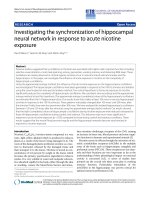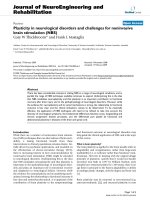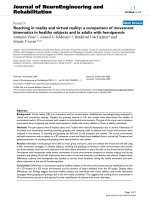báo cáo hóa học:" Biperiodicity in neutral-type delayed difference neural networks" pot
Bạn đang xem bản rút gọn của tài liệu. Xem và tải ngay bản đầy đủ của tài liệu tại đây (362.49 KB, 23 trang )
This Provisional PDF corresponds to the article as it appeared upon acceptance. Fully formatted
PDF and full text (HTML) versions will be made available soon.
Biperiodicity in neutral-type delayed difference neural networks
Advances in Difference Equations 2012, 2012:5 doi:10.1186/1687-1847-2012-5
Zhenkun Huang ()
Youssef N Raffoul ()
ISSN 1687-1847
Article type Research
Submission date 17 October 2011
Acceptance date 31 January 2012
Publication date 31 January 2012
Article URL />This peer-reviewed article was published immediately upon acceptance. It can be downloaded,
printed and distributed freely for any purposes (see copyright notice below).
For information about publishing your research in Advances in Difference Equations go to
/>For information about other SpringerOpen publications go to
Advances in Difference
Equations
© 2012 Huang and Raffoul ; licensee Springer.
This is an open access article distributed under the terms of the Creative Commons Attribution License ( />which permits unrestricted use, distribution, and reproduction in any medium, provided the original work is properly cited.
Biperiodicity in neutral-type delayed
difference neural networks
Zhenkun Huang
∗1
and Youssef N Raffoul
2
1
School of Science, Jimei University, Xiamen 361021, P. R. China
2
Department of Mathematics, University of Dayton,
Dayton, OH 45469-2316, USA
∗
Corresponding author:
Email address:
YNR: Youssef.Raff
Abstract
In this article we employ Krasnoselskii’s fixed point theorem to obtain new biperiodicity
criteria for neutral-type difference neural networks with delays. It is shown that the
neutral-type term can leads to biperiodicity results. That is coexistence of a positive
p eriodic sequence solution and its anti-sign periodic sequence solution. We illustrate
our novel approach the biperiodicity dynamics of biperiodicity for neutral-type delay
difference neural networks by two computer numerical examples.
Mathematics Subject Classification 2010: 39A23; 39A10.
Keywords: difference neural networks; biperiodicity; neutral-type; delayed.
1 Introduction
It is well known that neural networks with delays have a rich dynamical behavior that have
been recently investigated by Huand and Li [1] and the references therein. It is naturally
important that such systems should contain some information regarding the past rate of
change since they effectively describe and model the dynamic of the application of neural
networks [2–4]. As a consequence, scholars and researchers have paid more attention to the
stability of neural networks that are described by nonlinear delay differential equations of
the neutral type (see [4–8])
˙u
i
(t) = −a
i
(t)u
i
(t) +
m
j=1
b
ij
(t)g
j
(u
j
(t)) +
m
j=1
c
ij
˙u
j
(t − τ)
+
m
j=1
d
ij
(t)g
j
t
−∞
h
j
(t − s)u
j
(s)ds
+ I
i
(t), i ∈ N := {1, 2, · · · , m} (1.1)
Cheng et al. first investigated the globally asymptotic stability of a class of neutral-type
neural networks with delays [6]. Delay-dependent criterion has been attained in [5] by us-
1
ing Lyapunov stability theory and linear matrix inequality. Recently, a conservative robust
stability criteria for neutral-type networks with delays are proposed in [4] by using a new
Lyapunov–Krasovskii functional and a novel series compensation technique. For more rela-
tive results, we can refer to [4,7] and references cited therein.
Difference equations or discrete-time analogs of differential equations can preserve the
convergence dynamics of their continuous-time counterparts in some degree [9]. So, due to
its usage in computer simulations and applications, these discrete-type or difference networks
have been deeply discussed by the authors of [10–15] and extended to periodic or almost
periodic difference neural systems [16–21].
However, few papers deal with multiperiodicity of neutral-type difference neural net-
works with delays. Stimulated by the articles [22,23], in this article, we should consider
corresponding neutral-type difference version of (1.1) as follows:
u
i
(n + 1) = a
i
(n)u
i
(n) +
m
j=1
c
ij
u
j
(n − τ) +
m
j=1
b
ij
(n)g
j
(u
j
(n))
+
m
j=1
d
ij
(n)g
j
∞
v=1
h
j
(v)u
j
(n − v)
+ I
i
(n), (1.2)
where i ∈ N := {1, 2, . . . , m}. Our main aim is to study biperiodicity of the above neutral-
type difference neural networks. Some new criteria for coexistence of a perio dic sequence
solution and anti-sign periodic one of (1.2) have been derived by using Krasnoselskii’s fixed
point theorem. Our results are completely different from monop eriodicity existing ones in
[16–20].
The rest of this article is organized as follows. In Section 2, we shall make some prepa-
rations by giving some lemmas and Krasnoselskii’s fixed point theorem. In Section 3, we
gives new criteria for biperiodicity of (1.2). Finally, two numerical examples are given to
illustrate our results.
2 Preliminaries
We begin this section by introducing some notations and some lemmas. Let S
T
be the set
of all real T -periodic sequences defined on Z, where T is an integer with T ≥ 1. Then S
T
is
a Banach space when it is endowed with the norm
u
= max
i∈N
sup
s∈[0,T ]
Z
u
i
(s)
.
Denote [a, b ]
Z
:= {a, a + 1, . . . , b}, where a, b ∈ Z and a ≤ b. Let C((−∞, 0]
Z
, R
m
) be
the set of all continuous and bounded functions ψ(s) = (ψ
1
(s), ψ
2
(s), . . . , ψ
m
(s))
T
mapping
(−∞, 0]
Z
into R
m
. For any given ψ ∈ C((−∞, 0]
Z
, R
N
), we denote by {u(n; ψ)} the sequence
solution of system (1.2). Next, we present the basic assumptions:
2
• Assumption (H
1
): Each a
i
(·), b
ij
(·), d
ij
(·), and I
i
(·) are T-periodic functions defined
on Z, 0 < a
i
(n) < 1. The activation g
j
(·) is strictly increasing and bounded with
−g
j
= lim
v→−∞
g
j
(v) < g
j
(v) < lim
v→+ ∞
g
j
(v) = g
j
for all v ∈ R. The kernel
h
j
: N → R
+
is a bounded sequence with
∞
v=1
h
j
(v) = 1, where i, j ∈ N .
For each i ∈ N and any n ∈ Z, we let
G
i
(n, p) =
n+T −1
s=p+1
a
i
(s)
1 −
n+T −1
s=n
a
i
(s)
−1
, p ∈ [n, n + T − 1] (2.1)
Since 0 < a
i
(n) < 1 for all n ∈ [0, T − 1], each G
i
(n, p) is not zero and
m
i
:= min{G
i
(n, p) : n ≥ 0, p ≤ T } = G
i
(n, n) = G
i
(0, 0) > 0,
M
i
:= max{G
i
(n, p) : n ≥ 0, p ≤ T } = G
i
(n, n + T − 1) = G
i
(0, T − 1) > 0.
Lemma 2.1. For each i ∈ N and ∀p ∈ Z
+
,
S
p−1
s=0
a
−1
i
(s)
u
i
(p − τ) + u
i
(p − τ)
p−1
s=0
a
−1
i
(s)
=
p−1
s=0
a
−1
i
(s)u
i
(p − τ)
holds for any sequence solution {u(n)} of (1.2), where S is a shift operator defined as
S u
i
(p) = u
i
(p + 1) for i ∈ N and p ∈ Z
+
.
Proof.
S
p−1
s=0
a
−1
i
(s)
u
i
(p − τ) + u
i
(p − τ)
p−1
s=0
a
−1
i
(s)
=
p
s=0
a
−1
i
(s)
u
i
(p + 1 − τ) − u
i
(p − τ)
+ u
i
(p − τ)
p
s=0
a
−1
i
(s) −
p−1
s=0
a
−1
i
(s)
=
p
s=0
a
−1
i
(s)u
i
(p + 1 − τ) −
p−1
s=0
a
−1
i
(s)u
i
(p − τ)
=
p−1
s=0
a
−1
i
(s)u
i
(p − τ)
.
The proof is complete.
Lemma 2.2. Assume that (H
1
) hold. Any sequence {u(n)} ∈ S
m
T
:= S
T
× S
T
× · · · × S
T
m
is a solution of (1.2) if and only if
u
i
(n) =
m
j=1
c
ij
u
j
(n − τ) +
n+T −1
p=n
G
i
(n, p)
m
j=1
b
ij
(p)g
j
(u
j
(p))
+
m
j=1
d
ij
(p)g
j
∞
v=1
h
j
(v)u
j
(p − v)
+ I
i
(p) −
m
j=1
c
ij
u
j
(p − τ)(1 − a
i
(p))
, (2.2)
3
where G
i
(n, p) is defined by (2.1) for i ∈ N and p ∈ Z
+
.
Proof. Rewrite (1.2) as
u
i
(n)
n−1
s=0
a
−1
i
(s)
=
m
j=1
c
ij
u
j
(n − τ) +
m
j=1
b
ij
(n)g
j
(u
j
(n))
+
m
j=1
d
ij
(n)g
j
∞
v=1
h
j
(v)u
j
(n − v)
+ I
i
(n)
n
s=0
a
−1
i
(s), (2.3)
where i ∈ N and n ∈ Z
+
. Summing (2.3) from n to n + T − 1, we obtain
n+T −1
p=n
u
i
(p)
p−1
s=0
a
−1
i
(s)
=
n+T −1
p=n
m
j=1
c
ij
u
j
(p − τ) +
m
j=1
b
ij
(p)g
j
(u
j
(p))
+
m
j=1
d
ij
(p)g
j
∞
v=1
h
j
(v)u
j
(p − v)
+ I
i
(p)
p
s=0
a
−1
i
(s).
That is,
u
i
(n + T )
n+T −1
s=0
a
−1
i
(s) − u
i
(n)
n−1
s=0
a
−1
i
(s)
=
n+T −1
p=n
m
j=1
c
ij
u
j
(p − τ) +
m
j=1
b
ij
(p)g
j
(u
j
(p))
+
m
j=1
d
ij
(p)g
j
∞
v=1
h
j
(v)u
j
(p − v)
+ I
i
(p)
p
s=0
a
−1
i
(s).
Since u
i
(n + T ) = u
i
(n), we obtain
u
i
(n)
n+T −1
s=0
a
−1
i
(s) −
n−1
s=0
a
−1
i
(s)
=
n+T −1
p=n
m
j=1
c
ij
u
j
(p − τ) +
m
j=1
b
ij
(p)g
j
(u
j
(p))
+
m
j=1
d
ij
(p)g
j
∞
v=1
h
j
(v)u
j
(p − v)
+ I
i
(p)
p
s=0
a
−1
i
(s). (2.4)
4
It follows from Lemma 2.1 that
n+T −1
p=n
m
j=1
c
ij
u
j
(p − τ)
p
s=0
a
−1
i
(s) =
n+T −1
p=n
m
j=1
c
ij
u
j
(p − τ)S
p−1
s=0
a
−1
i
(s)
=
n+T −1
p=n
m
j=1
c
ij
u
j
(p − τ)
p−1
s=0
a
−1
i
(s)
− u
j
(p − τ)
p−1
s=0
a
−1
i
(s)
=
m
j=1
c
ij
n+T −1
p=n
u
j
(p − τ)
p−1
s=0
a
−1
i
(s)
−
n+T −1
p=n
m
j=1
c
ij
u
j
(p − τ)
p−1
s=0
a
−1
i
(s)
=
m
j=1
c
ij
u
j
(n − τ)
n+T −1
s=0
a
−1
i
(s) −
n−1
s=0
a
−1
i
(s)
−
n+T −1
p=n
m
j=1
c
ij
u
j
(p − τ)
u−1
s=0
a
−1
i
(s)
.
Therefore, one gets from (2.4) that
u
i
(n)
n+T −1
s=0
a
−1
i
(s) −
n−1
s=0
a
−1
i
(s)
=
m
j=1
c
ij
u
j
(n − τ)
n+T −1
s=0
a
−1
i
(s) −
n−1
s=0
a
−1
i
(s)
−
n+T −1
p=n
m
j=1
c
ij
u
j
(p − τ)(1 − a
i
(p))
p
s=0
a
−1
i
(s) +
n+T −1
p=n
m
j=1
b
ij
(p)g
j
(u
j
(p))
+
m
j=1
d
ij
(p)g
j
∞
v=1
h
j
(v)u
j
(p − v)
+ I
i
(p)
p
s=0
a
−1
i
(s).
Dividing both sides of the above equation by
n+T −1
s=0
a
−1
i
(s)−
n−1
s=0
a
−1
i
(s) completes the proof.
In what follows, we state Krasnoselskii’s theorem.
Lemma 2.3. Let M be a closed convex nonempty subset of a Banach space (B, · ).
Suppose that C and B map M into B such that
(i) x, y ∈ M implies that Cx + By ∈ M,
(ii) C is continuous and CM is contained in a compact set and
(iii) B is a contraction mapping.
Then there exists a z ∈ M with z = Cz + Bz.
3 Biperiodicity of neutral-type difference networks
Due to the introduction of the neutral term neutral
m
j=1
c
ij
, we must construct two closed
convex subsets B
L
and B
R
in S
m
T
, which necessitate the use of Krasnoselskii’s fixed point
theorem. As a consequence, we are able to derive the new biperiodicity criteria for (1.2).
That is there exists a positive T -periodic sequence solution in B
R
and an anti-sign T -periodic
sequence solution in B
L
. Next, for the case c
ij
≥ 0, we present the following assumption:
5
• Assumption (H
2
): For each i, j ∈ N, c
ij
≥ 0, b
ii
(n) > 0 and 0 < ˆc
i
:=
m
j=1
c
ij
< 1,
g
j
(·) satisfies g
j
(−v) = −g
j
(v) for all v ∈ R . Moreover, there exist constants α > 0
and β > 0 with α < β such that for all i ∈ N
−
1 − ˆc
i
m
i
T
α + b
ii
(n)g
i
(α)
− (1 − a
i
(n))ˆc
i
β > P
i
,
−
−
1 − ˆc
i
M
i
T
β + b
ii
(n)g
i
(β)
+ (1 − a
i
(n))ˆc
i
α > P
i
,
∀n ∈ Z
where
P
i
:= sup
n∈Z
j=i
|b
ij
(n)|g
j
+
m
j=1
|d
ij
(n)|g
j
+ |I
i
(n)|
, i ∈ N
Construct two subsets of S
T
as follows:
B
l
:=
w ∈ S
T
− β ≤ w(n) ≤ −α
, B
r
:=
w ∈ S
T
α ≤ w(n) ≤ β
.
Obviously, B
L
:= B
l
× B
l
· · · × B
l
m
and B
R
:= B
r
× B
r
· · · × B
r
m
are two closed convex
subsets of Banach space S
m
T
. Define the map B
Σ
: B
Σ
→ S
m
T
by
(B
Σ
u)
i
(n) =
m
j=1
c
ij
u
j
(n − τ), i ∈ N
and the map C
Σ
: B
Σ
→ S
m
T
by
(C
Σ
u)
i
(n) =
n+T −1
p=n
G
i
(n, p)
m
j=1
b
ij
(p)g
j
(u
j
(p))
−
m
j=1
c
ij
u
j
(p − τ)(1 − a
i
(p))
+
m
j=1
d
ij
(p)g
j
∞
v=1
h
j
(v)u
j
(p − v)
+ I
i
(p)
, i ∈ N (3.1)
where Σ = R or L. Due to the fact 0 < ˆc
i
< 1, B
Σ
defines a contraction mapping.
Proposition 3.1. Under the basic assumptions (H
1
) and (H
2
), for each Σ, the operator C
Σ
is completely continuous on B
Σ
.
Proof. For any given Σ and u ∈ B
Σ
, we have two cases for the estimation of (C
Σ
u)
i
(n).
• Case 1: As Σ = R and u ∈ B
R
, u
i
(n) ∈ [α, β] holds for each i ∈ N and all n ∈ Z. It
6
follows from (3.1) and (H
2
) that
(C
R
u)
i
(n) ≤
n+T −1
p=n
G
i
(n, p)
b
ii
(p)g
i
(β) +
j=i
|b
ij
(p)|g
j
−
m
j=1
c
ij
α(1 − a
i
(p))
+
m
j=1
|d
ij
(p)|g
j
+ |I
i
(p)|
≤
n+T −1
p=n
G
i
(n, p)
− ˆc
i
(1 − a
i
(p))α + b
ii
(p)g
i
(β) + P
i
≤ T M
i
1 − ˆc
i
M
i
T
β = (1 − ˆc
i
)β
and
(C
R
u)
i
(n) ≥
n+T −1
p=n
G
i
(n, p)
b
ii
(p)g
i
(α) −
j=i
|b
ij
(p)|g
j
−
m
j=1
c
ij
β(1 − a
i
(p))
−
m
j=1
|d
ij
(p)|g
j
− |I
i
(p)|
≥
n+T −1
p=n
G
i
(n, p)
− ˆc
i
(1 − a
i
(p))β + b
ii
(p)g
i
(α) − P
i
≥ T m
i
1 − ˆc
i
m
i
T
α = (1 − ˆc
i
)α.
• Case 2: As Σ = L and u ∈ B
L
, u
i
(n) ∈ [−β, −α] holds for each i ∈ N and all n ∈ Z.
It follows from (3.1) and (H
2
) that
(C
L
u)
i
(n) ≥
n+T −1
p=n
G
i
(n, p)
b
ii
(p)g
i
(−β) −
j=i
|b
ij
(p)|g
j
−
m
j=1
c
ij
(−α)(1 − a
i
(p))
−
m
j=1
|d
ij
(p)|g
j
− |I
i
(p)|
≥
n+T −1
p=n
G
i
(n, p)
ˆc
i
(1 − a
i
(p))α − b
ii
(p)g
i
(β) − P
i
≥ T M
i
1 − ˆc
i
M
i
T
(−β) = −(1 − ˆc
i
)β
7
and
(C
L
u)
i
(n) ≤
n+T −1
p=n
G
i
(n, p)
b
ii
(p)g
i
(−α) +
j=i
|b
ij
(p)|g
j
−
m
j=1
c
ij
(−β)(1 − a
i
(p))
+
m
j=1
|d
ij
(p)|g
j
+ |I
i
(p)|
≤
n+T −1
p=n
G
i
(n, p)
ˆc
i
(1 − a
i
(p))β − b
ii
(p)g
i
(α) + P
i
≤ T m
i
1 − ˆc
i
m
i
T
(−α) = −(1 − ˆc
i
)α.
It follows from above two cases about the estimation of (C
Σ
u)
i
(n) that C
Σ
u ≤ (1 −
min{ˆc
i
})β ≤ β. This shows that C
Σ
(B
Σ
) is uniformly bounded. Together with the continu-
ity of C
Σ
, for any bounded sequence {ψ
n
} in B
Σ
, we know that there exists a subsequence
{ψ
n
k
} in B
Σ
such that {C
Σ
(ψ
n
k
)} is convergent in C
Σ
(B
Σ
). Therefore, C
Σ
is compact on
B
Σ
. This completes the proof.
Theorem 3.1. Under the basic assumptions (H
1
) and (H
2
), for each Σ, (1.2) has a T-
periodic solution u
Σ
satisfying u
Σ
∈ B
Σ
.
Proof. Let u, ˆu ∈ B
Σ
. We should show that B
Σ
u + C
Σ
ˆu ∈ B
Σ
. For simplicity, we only
consider the case Σ = R. It follows from (2.2) and (H
2
) that
(B
R
u)
i
(n) + (C
R
ˆu)
i
(n) =
m
j=1
c
ij
u
j
(n − τ)
+
n+T −1
p=n
G
i
(n, p)
m
j=1
b
ij
(p)g
j
(ˆu
j
(p)) −
m
j=1
c
ij
ˆu
j
(p − τ)(1 − a
i
(p))
+
m
j=1
d
ij
(p)g
j
∞
v=1
h
j
(v)ˆu
j
(p − v)
+ I
i
(p)
≤
m
j=1
c
ij
β +
n+T −1
p=n
G
i
(n, p)
b
ii
(p)g
i
(β) +
j=i
|b
ij
(p)|g
j
−
m
j=1
c
ij
α(1 − a
i
(p)) +
m
j=1
|d
ij
(p)|g
j
+ |I
i
(p)|
≤ ˆc
i
β + T M
i
1 − ˆc
i
M
i
T
β = β.
8
On the other hand,
(B
R
u)
i
(n) + (C
R
ˆu)
i
(n) =
m
j=1
c
ij
u
j
(n − τ)
+
n+T −1
p=n
G
i
(n, p)
m
j=1
b
ij
(p)g
j
(ˆu
j
(p)) −
m
j=1
c
ij
ˆu
j
(p − τ)(1 − a
i
(p))
+
m
j=1
d
ij
(p)g
j
∞
v=1
h
j
(v)ˆu
j
(p − v)
+ I
i
(p)
≥
m
j=1
c
ij
α +
n+T −1
p=n
G
i
(n, p)
b
ii
(p)g
i
(α) −
j=i
|b
ij
(p)|g
j
−
m
j=1
c
ij
β(1 − a
i
(p)) −
m
j=1
|d
ij
(p)|g
j
− |I
i
(p)|
≥ ˆc
i
α + T m
i
1 − ˆc
i
m
i
T
α = α.
Therefore, all the hypotheses stated in Lemma 2.3 are satisfied. Hence, (1.2) has a T -
periodic solution u
R
satisfying u
R
∈ B
R
. Almost the same argument can be done for the
case Σ = L. The proof is complete.
For the case c
ij
≤ 0, we present the following assumption:
• Assumption (
H
2
): For each i, j ∈ N , c
ij
≤ 0 and −1 < ˆc
i
:=
m
j=1
c
ij
< 0. There
exist constants α > 0 and β > 0 with α < β such that for all n ∈ Z
(1 − a
i
(n))ˆc
i
β +
β − ˆc
i
α
M
i
T
> Q
i
,
−(1 − a
i
(n))ˆc
i
α +
ˆc
i
β − α
m
i
T
> Q
i
.
where
Q
i
:= sup
n∈Z
m
j=1
(|b
ij
(n)| + |d
ij
(n)|)g
j
+ |I
i
(n)|
.
Similarly as Proposition 3.1, we can obtain
Proposition 3.2. Under the basic assumptions (H
1
) and (
H
2
), for each Σ, the operator C
Σ
is completely continuous on B
Σ
.
Proof For any given Σ and u ∈ B
Σ
, we have two cases for the estimation of (C
Σ
u)
i
(n).
• Case 1: As Σ = R and u ∈ B
R
, u
i
(n) ∈ [α, β] holds for each i ∈ N and all n ∈ Z. It
follows from (3.1) and (
H
2
) that
(C
R
u)
i
(n) ≤
n+T −1
p=n
G
i
(n, p)
−
m
j=1
c
ij
β(1 − a
i
(p)) + Q
i
≤ T M
i
β − ˆc
i
α
M
i
T
= β − ˆc
i
α
9
and
(C
R
u)
i
(n) ≥
n+T −1
p=n
G
i
(n, p)
−
m
j=1
c
ij
α(1 − a
i
(p)) − Q
i
≥ T m
i
α − ˆc
i
β
m
i
T
= α − ˆc
i
β.
• Case 2: As Σ = L and u ∈ B
L
, u
i
(n) ∈ [−β, −α] holds for each i ∈ N and all n ∈ Z.
It follows from (3.1) and (
H
2
) that
(C
L
u)
i
(n) ≥
n+T −1
p=n
G
i
(n, p)
−
m
j=1
c
ij
(−β)(1 − a
i
(p)) − Q
i
≥ T M
i
ˆc
i
α − β
M
i
T
= ˆc
i
α − β
and
(C
L
u)
i
(n) ≤
n+T −1
p=n
G
i
(n, p)
−
m
j=1
c
ij
(−α)(1 − a
i
(p)) + Q
i
≤ T m
i
ˆc
i
β − α
m
i
T
= ˆc
i
β − α.
By a similar argument, we prove that C
Σ
is continuous and compact on B
Σ
. This completes
the proof.
Theorem 3.2. Under the basic assumptions (H
1
) and (
H
2
), for each Σ, (1.2) has a T-
periodic solution u
Σ
satisfying u
Σ
∈ B
Σ
.
Proof. Let u, ˆu ∈ B
Σ
. We should show that B
Σ
u + C
Σ
ˆu ∈ B
Σ
. For simplicity, we only
consider the case Σ = L. It follows from (2.2) and (
H
2
) that
(B
L
u)
i
(n) + (C
L
ˆu)
i
(n) =
m
j=1
c
ij
u
j
(n − τ)
+
n+T −1
p=n
G
i
(n, p)
m
j=1
b
ij
(p)g
j
(ˆu
j
(p)) −
m
j=1
c
ij
ˆu
j
(p − τ)(1 − a
i
(p))
+
m
j=1
d
ij
(p)g
j
∞
v=1
h
j
(v)ˆu
j
(p − v)
+ I
i
(p)
≤
m
j=1
c
ij
(−β) +
n+T −1
p=n
G
i
(n, p)
−
m
j=1
c
ij
(−α)(1 − a
i
(p)) + Q
i
≤ −ˆc
i
β + T m
i
ˆc
i
β − α
m
i
T
= −α.
10
On the other hand,
(B
L
u)
i
(n) + (C
L
ˆu)
i
(n) =
m
j=1
c
ij
u
j
(n − τ)
+
n+T −1
p=n
G
i
(n, p)
m
j=1
b
ij
(p)g
j
(ˆu
j
(p)) −
m
j=1
c
ij
ˆu
j
(p − τ)(1 − a
i
(p))
+
m
j=1
d
ij
(p)g
j
∞
v=1
h
j
(v)ˆu
j
(p − v)
+ I
i
(p)
≥
m
j=1
c
ij
(−α) +
n+T −1
p=n
G
i
(n, p)
−
m
j=1
c
ij
(−β)(1 − a
i
(p)) − Q
i
≥ −ˆc
i
α + T M
i
ˆc
i
α − β
M
i
T
= −β.
Therefore, all the hypotheses stated in Lemma 2.3 are satisfied. Hence, (1.2) has a T -periodic
solution u
L
satisfying u
L
∈ B
L
. By a similar argument, one can prove the case Σ = R.
This completes the proof.
4 Numerical examples
Example 1. Consider the following neutral-type difference neural networks with delays
u
i
(n + 1) = a
i
(n)u
i
(n) +
3
j=1
c
ij
u
j
(n − τ) +
3
j=1
b
ij
(n)g
j
(u
j
(n))
+
3
j=1
d
ij
(n)g
j
∞
v=1
h
j
(v)u
j
(n − v)
+ I
i
(n), (4.1)
where
a
1
(n) = a
2
(n) = a
3
(n) := exp
− 0.1 − 0.01 cos 0.2πn
,
I
1
(n) := 0.02 cos 0.2πn, I
2
(n) := 0.03 sin 0.2πn,
I
3
(n) := 0.2 sin 0.2πn, τ = 5, g(z) := g
1
(z) = g
2
(z) = tanh(z), m = 3,
C = (c
ij
) =
0.2 0.1 0 .05
0.1 0.25 0
0.05 0.1 0 .2
, h
1
(10) = h
2
(10) = h
3
(10) = 1, T = 10,
D(n) = (d
ij
(n)) =
0 0.05 cos(0.2πn) 0
0.1 sin(0.2πn) 0 0
0 0 0.01 sin(0.2πn)
,
B(n) = (b
ij
(n)) =
7 + sin(0.2πn) 0.1 sin(0.2πn) 0.01 sin(0.2πn)
0.1 cos(0.2πn) 7 + sin(0.2πn) 0
0.01 sin(0.2πn) 0 7 + sin(0.2π n )
.
11
Obviously, the sigmoidal function tanh(z) is strictly increasing on R with | tanh(z)| < 1. It
is easy for us to check that (H
1
) holds. After some computations, we have
ˆc
1
= ˆc
2
= ˆc
3
= 0.35, m
1
= m
2
= m
3
= 0.6496,
M
1
= M
2
= M
3
= 1.2720, P
1
= 0.18, P
2
= 0.23, P
3
= 0.22.
Take α = 3, β = 160 and define
S
1
(n) := (1 − a
i
(n))ˆc
i
α −
−
1 − ˆc
i
M
i
T
β + b
ii
(n)g
i
(β)
S
2
(n) :=
−
1 − ˆc
i
m
i
T
α + b
ii
(n)g
i
(α)
− (1 − a
i
(n))ˆc
i
β
From Figure 1, we can check that assumption (H
2
) hold. By Theorem 3.1, there exists a
positive ten-periodic sequence solution of (4.1) and a negative ten-periodic sequence solution.
For the coexistence of positive periodic sequence solution and its anti-sgn ones, we can refer
to Figures 2 and 3. Phase view for biperio dicity dynamics of (4.1), we can refer to Figure 4.
Example 2. Consider the following neutral-type difference neural networks with delays
u
i
(n + 1) = a
i
(n)u
i
(n) +
2
j=1
c
ij
u
j
(n − τ) +
2
j=1
b
ij
(n)g
j
(u
j
(n)) + I
i
(n), (4.2)
where
a
1
(n) := exp
− 0.1 − 0.01 cos 0.2πn
, a
2
(n) := exp
− 0.2 − 0.1 sin 0.2πn
,
I
1
(n) := 0.02 sin 0.2πn, I
2
(n) := 0.02 cos 0.2πn, τ = 5, g(z) := g
1
(z) = g
2
(z) = tanh(z),
C = (c
ij
) =
−0.1 −0.2
−0.2 −0.1
, T = 10, B(n) =
0.5 0.005 sin(0.2πn)
0.1 cos(0.2πn) 0.5
.
Obviously, (H
1
) holds. From some computations, we have
ˆc
1
= ˆc
2
= −0.3, m
1
= 0.6496, m
2
= 0.1912,
M
1
= 1.2720, M
2
= 0.8222, Q
1
= 0.525, Q
2
= 0.62.
Let α = 1, β = 20. We can check assumption (
H
2
) holds. From Theorem 3.2, there exist
a positive ten-periodic sequence solution and an anti-sgn ones of (4.2). For the coexistence
of a positive T -periodic sequence solution and its an anti-sgn ones of (4.2), we can refer to
Figure 5. Figure 6 shows phase view for biperiodicity dynamics of (4.2).
12
5 Remarks and open problems
To the best of authors’ knowledge, this is the first time when biperiodicity criteria for
neutral-type difference neural networks with delays
u
i
(n + 1) − a
i
(n)u
i
(n) =
m
j=1
c
ij
u
j
(n − τ) +
m
j=1
b
ij
(n)g
j
(u
j
(n))
+
m
j=1
d
ij
(n)g
j
∞
v=1
h
j
(v)u
j
(n − v)
+ I
i
(n), i ∈ N
have been studied.
We propose the following open problems for future research:
Our new assumptions (H
2
) and (
H
2
) indicate that neutral term plays an important role
on the dynamics of biperiodicity. Such study has not been mentioned in the literature.
However, there is still more to do. For example:
(i) If we relax the conditions c
ij
≤ 0 or c
ij
≥ 0 for all i, j ∈ N on the neutral term, then is
the existence of multiperiodic dynamics still exist?
(ii) Evidently, in our work Biperiodicity of neural networks depends on the boundedness of
activation functions. Can such requirement be relaxed and yet still obtain periodic sequence
solutions and whether they are always of anti-sign?
To discuss the sign of each c
ij
and consider analytic properties of activation functions is
a possible way to investigate these problems.
Competing interests
The authors declare that they have no competing interests.
Authors’ contributions
All the authors have contributed in all the part and they have read and approved the final
manuscript.
Acknowledgements
This research was supported by National Natural Science Foundation of China under Grant
11101187, the Foundation for Young Professors of Jimei University and the Foundation of
Fujian Higher Education (JA10184,JA11154,JA11144).
13
References
[1] Huang, LH, Li XM: Dynamics of Cellular Neural Networks. Science Press, Beijing
(2007)
[2] Bellen, A, Guglielmi, N, Ruehli, AE: Methods for linear systems of circuit delay differ-
ential equations of neutral type. IEEE Trans. Circuits Syst. I. Fundam. Theory Appl.
46, 212–215 (1999)
[3] Clarkson, ID, Goodall, DP: On the stabilizability of imperfectly known nonlinear delay
systems of the neutral type. IEEE Trans. Autom. Control. 45, 2326–2331 (2000)
[4] Zhang, HG, Liu, ZW, Huang, GB: Novel delay-dependent robust stability analysis for
switched neutral-type neural networks with time-varying dalays via SC technique. IEEE
Trans. Syst. Man, Cyber. B: Cybernetics 40, 1480–1491 (2010)
[5] Park, JH, Kwon, OM, Lee, SM: LMI optimization approach on stability for delayed
neural network of neutral-type. J. Comput. Appl. Math. 196, 224–236 (2008)
[6] Cheng, CJ, Liao, TL, Yan, JJ, Hwang, CC: Globally Asymptotic Stability of a Class
of Neutral-Type Neural Networks With Delays. IEEE Trans. Syst. Man Cybern. B:
Cybernetics 36, 1191–1195 (2006)
[7] Samli, R, Arik, S: New results for global stability of a class of neutral-type neural
systems with time delays. Appl. Math. Comput. 210, 564–570 (2009)
[8] Rakkiyappan, P, Balasubramaniam, P: New global exponential stability results for neu-
tral type neural networks with distributed time delays. Neurocomputing 71, 1039–1045
(2008)
[9] Kelley, W, Perterson, A: Difference Equations: An Introduction with Applications.
Harcourt Acadamic Press, San Diego (2001)
[10] Chen, LN, Aihara, K: Chaos and asymptotical stability in discrete-time neural networks.
Physica D: Nonlinear Phenomena 104, 286–325 (1997)
[11] Liang, JL, Cao, JD, Ho, DWC:Discrete-time bidirectional associative memory neural
networks with variable delays. Phys. Lett. A 335, 226–234 (2005)
[12] Liu, YR, Wang, ZD, Serrano, A, Liu, XH: Discrete-time recurrent neural networks with
time-varying delays: Exponential stability analysis. Phys. Lett. A 362, 480–488 (2007)
[13] Mohamad S: Global exp onential stability in continuous-time and discrete-time delayed
bidirectional neural networks. Physica D 159, 233–51 (2001)
14
[14] Chen, WH, Lu, XM, Liang, DY: Global exponential stability for discrete-time neural
networks with variable delays. Phys. Lett. A 358,186-198(2006)
[15] Brucoli, M, Carnimeo, L, Grassi, G: Discrete-time cellular neural networks for associa-
tive memories with learning and forgetting capabilities. IEEE Trans. Circ. Sys. I 42,
396–399 (1995)
[16] Wang, L, Zou, X: Capacity of stable periodic solutions in discrete-time bidirectional
associative memory neural networks. IEEE Trans. Circ. Syst. II 51, 315–319 (2004)
[17] Zeng, ZG, Wang, J: Multiperiodicity of discrete-time delayed neural networks evoked
by periodic external inputs. IEEE Trans. Neural Netw. 17, 1141–1151 (2006)
[18] Zhao, HY, Sun, L, Wang, GL: Periodic oscillation of discrete-time bidirectional asso-
ciative memory neural networks. Neurocomputing 70, 2924–2930 (2007)
[19] Zou, L, Zhou, Z: Periodic solutions for nonautonomous discrete-time neural networks.
Appl. Math. Lett. 19, 174–185 (2006)
[20] Zhou, Z, Wu, JH: Stable periodic orbits in nonlinear discrete-time neural networks with
delayed feedback. Comput. Math. Appl. 45, 935–942 (2003)
[21] Huang, ZK, Wang, XH, Gao, F: The existence and global attractivity of almost periodic
sequence solution of discrete-time neural networks. Phys. Lett. A 350, 182–191 (2006)
[22] Raffoul, Y: Periodic solutions for scalar and vector nonlinear difference equations.
Panamer. J. Math. 9, 97–111 (1999)
[23] Raffoul, Y, Yankson, E: Positive periodic solutions in neutral delay difference equations.
Adv. Dyn. Syst. Appl. 5, 123–130 (2010)
Figure 1: The estimation of S
1
(n) and S
2
(n) for assumption (H
2
).
Figure 2: The existence of a positive T -periodic sequence solution of (4.1).
Figure 3: The existence of a negative T -periodic sequence solution of (4.1).
15
Figure 4: Phase view for biperiodicity of neutral-type difference neural networks
(4.1).
Figure 5: Coexistence of a positive T -periodic solution and its an anti-sgn ones
of (4.2).
Figure 6: Phase view of biperiodicity for neutral-type difference neural networks
(4.2).
16
0 10 20 30 40 50 60
0
0.5
1
1.5
2
2.5
S
1
(n)
S
2
(n)
Figure 1
10 20 30 40 50 60 70 80 90
70
75
80
85
n
u
u
1
(n)
u
2
(n)
u
3
(n)
Figure 2
10 20 30 40 50 60 70 80 90
−85
−80
−75
−70
u
1
(n)
u
2
(n)
u
3
(n)
Figure 3
−100
−50
0
50
100
−100
−50
0
50
100
−100
−50
0
50
100
u
1
u
2
u
3
Figure 4
10 20 30 40 50 60 70 80 90
−6
−4
−2
0
2
4
6
n
u
u
1
(n)
u
2
(n)
Figure 5
−6 −4 −2 0 2 4 6
−4
−3
−2
−1
0
1
2
3
4
u
1
u
2
Figure 6









